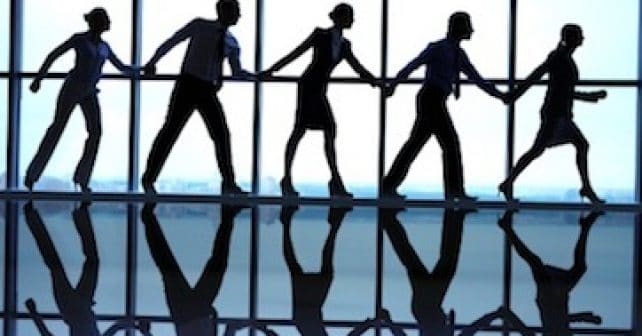
Inclusiveness has become something of a buzzword, especially in the wake of the #TimesUp, and #MeToo movements, but it’s not just about gender. Teams perform best and see greater levels of creativity when they leverage the experience and talents of a truly diverse group of people. In a Q&A, Veronica Augustsson, CEO of Swedish financial software firm Cinnober, talks about how her company fosters inclusiveness and the positive results they have seen. (Listen to the related podcast).
Q: What does inclusiveness in the workplace mean to you? How does your company foster this internally?
A: Inclusiveness, in general, is something we shouldn’t even have to talk about—it should be natural. But unfortunately, we actually do have to talk about it, because in my experience people, based on their experience and their background, tend to rely on things that they know about, and engage with people that seem similar to themselves, because it seems safer. But my experience is that if you mix different kinds of people, with different backgrounds, different mindsets, different cultures and so on, you actually get much better-quality work, and see much better results.
It would be no good having 350 Veronicas—it’s much better to have 350 different kinds of people. If you have that mindset, and if you’re giving everyone a chance, you’re open.
We look very actively at inclusiveness, and we talk a lot about it at the company. It started with us actively recruiting people with different backgrounds and different nationalities. We have over 40 different nationalities in our firm, which is not that common in Sweden. It might be common in other major cities, but for us it’s not a natural thing, so you have to work actively to get it. But it’s about much more than nationalities, it’s diversification in terms of age, gender, everything.
If you have ever been in a team that isn’t homogenous, and you actually see the results, you won’t go back to a very homogenous team. I’m very pleased that we have the team we have and with the different backgrounds we have. That enables us to maximize their talents.
Q: What do you think is the biggest value of having that diversity?
A: I think it’s the added creativity. If people think in different ways, it’s a catalyst for creativity. We had one new employee join us recently, and he said after one day at the company, “I’ve never been in a company that has this many great ideas. I find ideas everywhere.”
We have a fairly flat organization, and we look at people from a performance point of view. Cinnober has never really cared about titles, for example. People can pick their own titles, and of course, it’s good if you have something that actually describes what you’re doing, but that’s not what you’re going to be rewarded or get credibility for, it’s what you are actually delivering. I think that we have fostered a winning culture. No one wins on their own, they need their team in order to win. That team spirit fosters inclusiveness, because there is no way to win, if you do the race on your own, if you ignore your colleagues, or do not share information.
Of course, it is not totally flat, you need some structure as well. And there are differences between our Swedish and our London office. I can see tendencies in London where if someone goes past their boss to their boss’ boss, people all of a sudden think they have escalated something. But really, they have just gone to the person who can solve their issue. We try to take the best things from each office and learn from each other.
Q: How is inclusiveness different from fostering diversity, and what are your thoughts on diversity hiring quotas?
A: I think inclusiveness precedes diversification. Should we, quote, have 50-50 male-female, etc? My initial reaction is no, why should we? On the other hand, I think that having people from different backgrounds leads to more creativity and gets the group to actually perform better. If I were a shareholder in a company, I would see a value in the board and the management team having a diversified distribution amongst them. If there is no other way to open up people’s eyes and actually try it, maybe we have to go down that path.
However, if you do the gender thing, then you lose out on all the other things with diversity. I think it’s a hard question and I think it will probably take another generation or so before it is totally natural and we don’t even have to mention it. A generation or two ago, it was very unusual that a woman was even working. Nowadays, no one questions why women should work, and hopefully a generation from now, they will look at it as an odd thing to only have males on a board, for example.
Q: How can you try to change people’s attitudes with regards to inclusiveness?
A: If I’m talking to a man, for example, and he has a daughter, one way of looking at it would be to say, “When she begins her professional life and starts to build her own career, how do you want things to be for her?”
Very often when you make it personal and you make a use case of it, then they say, “Of course she should have the same rights as her brother.” Then you say, “Okay, but do you think in your company today, do you think that people here have the same rights or the same possibilities and do you look at them in the same way?” I think that making it personal, making it concrete, making them think, and getting them to the “aha” moment will probably help them to change their mindset and change the way they look at people.
I try to look at people as talents and not female, male, young, or old. Is this person a talent we can use or is this person not a talent we need?
I try to look at people as talents and not female, male, young, or old. Is this person a talent we can use or is this person not a talent we need?
I think a lot of things have to change, in business and in society, but I’m very hopeful for the next generation. I have two children and the way that the daycare and the school talk about inclusiveness and being gender neutral is fantastic. That wasn’t even a topic when I was three years old and started in daycare. I think a lot of that has changed, and when that generation joins the professional world, I’m very hopeful that we will see improvements in the way firms put together teams. The results will be much better tomorrow than today.
Q: Say there is a head of post-trade operations working for a mid-tier bank. He says he believes everything you have said about inclusiveness, but that he works for a big, old-fashioned American institution, and cannot change the culture there. What would you say to him? How can he foster inclusiveness within his team?
A: I often compare business with sport. Take Zlatan, the Swedish football player. You can’t have 11 Zlatan’s on the football field—it wouldn’t be any use to you. He would be a useless goalkeeper. You should keep him as the forward and find other people who are better suited to the other positions. Together everyone achieves more. Find a mix of people within your team that make each individual better. If you think that way, you can’t really have 10 people who are the same age, the same shoe size, or the same background, because no one can win the World Cup with 11 Zlatans.
If you are thinking about how to put together a great team, it is kind of obvious that you need different types of personalities.
I believe in making small changes—actually making change, not just talking about it but doing something. Every small step is a good step in the right direction, and eventually that snowball becomes bigger, and people will look at you and say, “How come you’re winning everything? How come you’re so successful?” And you will say, “Because I have this great team.”
It’s not only within companies that certain things have to be restructured or rethought, it’s actually the whole infrastructure and norms within society. Governments have a role to play and can do things like offer tax incentives to encourage people to embrace equality and inclusiveness. For example, Sweden introduced tax incentives for families to buy cleaning services, to make it easier for women to rejoin the workforce. Even though this should be a shared responsibility in the home, it is often the women who end up taking care of it, in addition to working and childcare. Making such services more easily available starts a conversation around equality and means that women can participate more fully in the workforce.
Q: What changes would you like to see take place generally in the next two years? What message would you send to the next generation of professional women?
It’s a hard question and I don’t think that there is a silver bullet answer to it. As much as I think that certain men have to change their view of inclusiveness and diversification, I also think certain women have to do it. Believe in yourself, for example—sometimes women have the tendency not to really opt in for maximising their potential.
Women need to believe in themselves and actually take the opportunities in front of them. Everyone is different, and you are not more different than anyone else. Be yourself—you are there because you are you, so don’t try to behave like someone else. I think that’s easier said than done, but that’s my recommendation to people.

